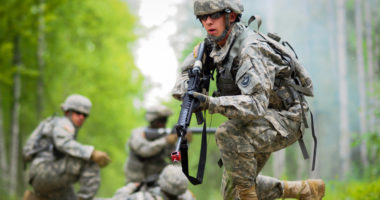As a 2022 global report by the World Health Organization estimates, about 1.3 billion people – or 16% of the world’s population, more than one in six people – have a disability. In armed-conflict affected areas, the number could be even higher, upwards of 18-30%. Beyond every figure, there are personal experiences and potentially lethal risks.
In this post, ICRC Senior Legal Adviser Alexander Breitegger outlines some of the barriers and risks persons with disabilities face during armed conflicts, the rules pertaining to their protection, and recommendations to pave the way towards a more disability-inclusive interpretation of international humanitarian law (IHL).
During a series of regional consultations in 2022, which brought together persons with disabilities and armed forces, this former group shared some of their stories with us: deaf persons who had been shot from behind and killed because they were seemingly mistaken for an enemy and could not understand the military was coming; a farmer and father of a child with an intellectual impairment who, during a major evacuation due to military operations, chose to evacuate his cow instead of his child, on the grounds that the cow was more valuable; families who faced the impossible dilemma of either leaving all together, slowed down and risking attack because a family member with mobility restrictions could not take their assistive devices with them, or saving the rest of the family and leaving the loved one with a disability behind; persons with disabilities interrupted during a workshop by hostilities and unable to hear the oral warnings to hide under the tables to keep safe.
These personal stories, along with others that we heard during the consultations, illustrate some of the specific risks to which persons with disabilities are exposed: attacks, violence, ill-treatment or detention by weapon bearers, or simply being left behind. Insufficient awareness of the diversity of persons with disabilities may lead to erroneous and dangerous assumptions – such as that persons with psychosocial disabilities pose a military threat – or it may lead to an increased risk of incidental harm due to the inaccessibility of warnings, shelters or evacuations.
These specific risks may then be exacerbated in different ways. First, by the destruction, damage or confiscation by armed forces of assistive devices, for instance at checkpoints. Assistive devices are indispensable for some persons with disabilities, enabling them to access their physical environment, to communicate, or to receive information. These concerns may also be exacerbated by other risks, such as those associated with the personal identity or pre-existing marginalization of children, women, older persons, internally displaced persons (IDPs), migrants with disabilities, or persons with disabilities living in remote rural areas.
Need for a more disability-inclusive implementation of existing IHL
As has been analyzed in detail here, here and here, these specific risks are not due to a lack of existing international humanitarian law (IHL) on the matter. Clearly, when they are civilians or persons hors de combat, persons with disabilities are protected under the general IHL rules on the conduct of hostilities (the principles of distinction, proportionality and precautions). When in the power of a party to an armed conflict, they benefit from fundamental guarantees, especially humane treatment, without any adverse distinction. Moreover, both treaty and customary IHL rules provide that persons with disabilities are entitled to special respect and protection under IHL.
We do not need new rules or new specific protection. What we need is to get better at taking into account the barriers faced by persons with disabilities in the interpretation and implementation of existing IHL rules.
For instance, ideally, armed forces and armed groups should have a minimum understanding that persons with sensory, psychosocial or intellectual disabilities may not be able to understand or react to hostilities occurring around them as other persons would. This could help to avoid that civilians with disabilities end up being subject to attack because their actions are misinterpreted as hostile.
Feasible precautions in attack is an area in which thoughtful awareness can make a big difference for persons with disabilities. To ensure that advance warnings of impending attacks (where military circumstances permit) effectively reach persons with disabilities, it is necessary to communicate such information in a variety of accessible formats. For persons with visual impairments, merely dropping leaflets from airplanes will not suffice. Persons who are hard of hearing may depend on text messages they receive on their smartphones.
Temporary evacuations may be another feasible precaution against the effect of military operations. In order for persons with disabilities to benefit fully from such evacuations, it is necessary to identify persons with disabilities, ensure accessible means of transport, allow for support persons to accompany them and make sure they can take assistive devices with them.
Interpreting IHL obligations in a manner that takes into account the risks and barriers faced also means treating persons with disabilities humanely in detention or other situations where they are under the control of a party to a conflict – including by handling assistive devices correctly, taking feasible measures to ensure accessibility of infrastructure and accessibility of communication in places of detention.
For the ICRC, promoting disability-inclusive interpretations and implementations of international humanitarian law is an institutional priority, in line with our organization’s Vision 2030 on Disability. Vision 2030 is designed to make the ICRC more inclusive for persons with disabilities in its humanitarian programming, as an employer, and as an advocate for a more inclusive legal and policy environment.
The complementarity with the Convention on the Rights of Persons with Disabilities (CRPD), which is explicit in Article 11, may help in increasing visibility of persons with disabilities substantively and procedurally. Substantively, the social and human rights model on disability enshrined in the CRPD may help broaden the analysis of specific barriers and risks faced by persons with disabilities in their diversity. Procedurally, serious consideration of these barriers and risks also requires closely consulting and actively involving persons with disabilities and their representative organizations in the interpretation and implementation of IHL (an obligation and principle of participation by persons with disabilities under the CRPD).
Participation by persons with disabilities in IHL-related discussions guided the regional consultations mentioned above, which the ICRC co-organized last year with the UN Special Rapporteur on the rights of persons with disabilities and his team, the International Disability Alliance, the European Disability Forum and the Diakonia IHL Centre. The very process and fact of having persons with disabilities and their representative organizations speak directly to militaries about the specific barriers and risks faced by them resulting from military operations in armed conflict was essential. It is more enlightening and more empowering to engage in direct dialogue, rather than for the ICRC or other stakeholders to relay those concerns to militaries on behalf of others. Surprisingly, this is not something that appears to have been done regularly or systematically.
Recommendations for the way forward
Following the regional consultations came an abundance of recommendations, expertly compiled by the UN Special Rapporteur and his team in his 2022 report to the UN General Assembly.
In the ICRC’s view, facilitation of more direct exchanges between persons with disabilities and the military would be very beneficial in terms of specific awareness raising with militaries as well as capacity building of organizations of persons with disabilities (OPDs) on IHL. States should look into the possibility of organizing more of these exchanges, be it on a national, regional or international level.
On a national level, national committees and similar entities on international humanitarian law would be interesting venues to explore, given that these forums discuss issues of national interest in terms of dissemination and implementation of IHL, and usually involve a multitude of stakeholders. Synergies with CRPD national implementation mechanisms should also be explored.
On an international level, the ICRC would like to see this issue feature at the dedicated multilateral forum where IHL and humanitarian action are discussed every four years: the International Conference of the Red Cross and the Red Crescent. It is a topic ripe for engagement among all states parties to the Geneva Conventions, all components of the Red Cross and Red Crescent Movement, as well as observers, to discuss challenges and good practices in relation to a disability-inclusive application of IHL. Pledges by conference participants would also be a useful tool to ensure follow-up actions, which could include: bringing this issue before national committees or similar entities on IHL; organizing exchanges between OPDs and armed forces; integrating the protection of persons with disabilities in armed conflict in military manuals or national legislation.
Seizing other opportunities where states can discuss thematic IHL issues could also be interesting, either in an individual capacity or for instance, within the UN, where there is already a dedicated UN Security Council Resolution 2475. This resolution provides a broad conceptual foundation for better inclusion of persons with disabilities in the protection of civilians agenda of the UN Security Council. However, the conversation should become more concrete in terms of IHL-related scenarios and how to address them. Enabling the participation of persons with disabilities as well as state representatives with a military technical background (for instance military attachés where they exist) could make a contribution to this end.
Military doctrine, in particular the law of armed conflict and military manuals should also integrate the specific barriers and risks faced by persons with disabilities in chapters on the protection of civilians, protection of detainees and so on. It is important to do this in a meaningful way, and not as an afterthought.
Ways should be found to better include OPDs in such processes. One possible vector to bring OPDs and militaries closer might be connections between OPDs and organizations of ex-combatants. Participation by OPDs and other civilian experts in more specific sensitization of armed forces should also be enhanced. This would usefully take the form of more practical hands-on training, based on scenarios, such as on cooperation and coordination of temporary evacuations of civilians, including civilians with disabilities.
Ideally, with time these efforts will result in the integration of specific barriers and risks by persons with disabilities into military planning and conduct of operations. Until then, what is absolutely key to progress is to continue raising awareness about the specific barriers and risks of civilians with disabilities in military operations in armed conflict. Such work may contribute to dismantling attitudinal barriers that taking such specific risks into account is unrealistic.
See also:
- Victoria Riello, “Nothing about us without us’: including civilians with disabilities in the aftermath”, November 15, 2022
- Helen Durham, Gerard Quinn, “Lifting the cloak of invisibility: civilians with disabilities in armed conflict”, April 21, 2022
- NG’AA Michael Mwendwa, “Disability and sexual violence in the COVID-19 era”, December 3, 2020






Comments